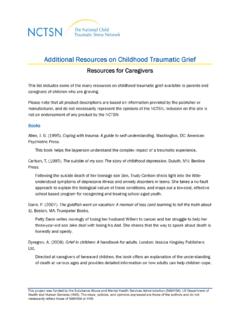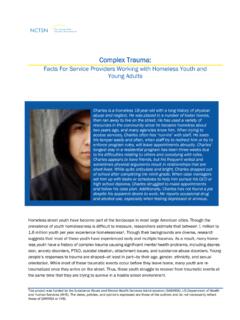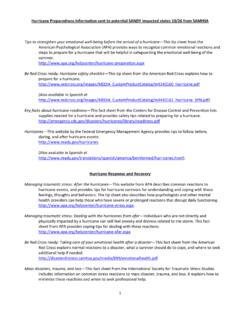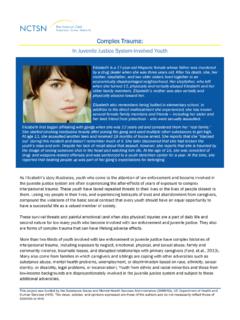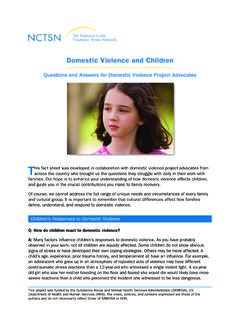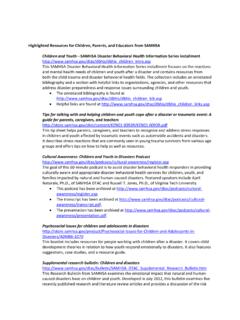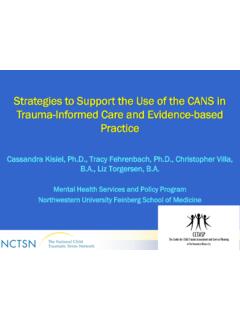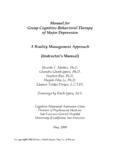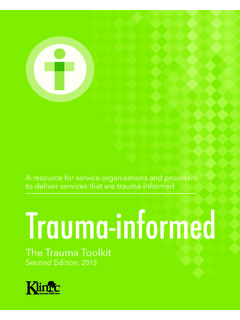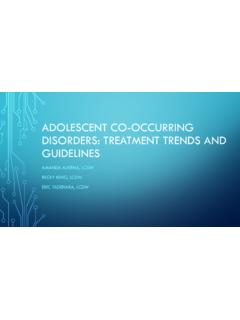Transcription of NME Core Concepts and Trauma Informed Practices
1 NME Core Concepts and Trauma Informed Practices Fire can warm or consume, water can quench or drown, wind can caress or cut. And so it is with human relationships; we can both create and destroy, nurture and terrorize, traumatize and heal each other. Bruce D. Perry Welcome to NME Core Concepts Welcome Trauma - ACEs & prevalence Trauma -Impact Sequential Brain development Trauma lens in the NME classroom Classroom support for ALL kids Organize and integrate Agenda Working Agreements Attention-getting signal Minimize off-topic volume Silence Cell phones, reduce side bars & non-note-taking-typing Everyone shares knowledge!
2 Participate to the degree you are comfortable Others? This training has a lot of information about Trauma and its many people in this room may have shared some of these experiences. If at any time you are uncomfortable and feel that you need a break, please take care of yourself! And, please, let a trainer know if you need any assistance. (And just ) the ACEs study, the prevalence and impact of childhood Trauma ( behavioral, developmental, social, and educational) and summarize the core components of neurosequential development and how the components increase positive outcomes for students, families/caregivers and stakeholders for more effective classroom management, curriculum planning, and regulatory activities utilizing the Neurosequential Model in Education (NME) lens in education examples of Practices to support all, some and few that are reflective of 6R s of NME classroom.
3 Outcomes: We ll all be able Paper Bag When someone uses the term Trauma .. what do you envision? Everyone at your table pulls one strip out of the bag Read your slip to the group Then everyone join into a dialogue around how your topic might or might not be considered Trauma All of the sentence strips in the bag are examples of possible traumatic events and experiences. Yet not all Trauma leads to disaster- even when Trauma has occurred, we have real reason for hope! We can support families, staff, and our community to build resilience through relational interactions.
4 Trauma Did you consider some of the experiences traumatic ? And if they were considered traumatic .. what made them so? Did you have additional questions during your dialogue? Did you have some commonalities within your group? Did you wonder why some children move through a traumatic experience and other children are significantly impacted? Resiliency is essentially the capacity to face a stressor or a life experience that s challenging .. without having any significant damaging impact on the individual. If a student suffers grief, they would feel loss and a normal range of emotions.
5 But over time, it wouldn t interrupt their ability to go to school and to lead a healthy life. That s resilience. Dr. Bruce Perry Resiliency ChildTrauma Academy (CTA) is a not-for-profit organization based in Houston, Texas, working to improve the lives of high-risk children through direct service, research, and education. Dr. Perry began this work at the University of Chicago, and later moved the organization to Houston. Dr. Perry and his colleagues realized that the information from research around childhood experiences was key to developing trainings and interventions that could help children who have experienced Trauma .
6 By creating biologically-and- Trauma - Informed practice, CTA has advanced its mission to help children who have experienced Trauma and neglect. May we introduce Dr. Bruce Perry (intro video to follow) Dr. Bruce Perry Video Sequential/Neurodevelopment The brain is undeveloped at birth The brain organizes from the bottom up - brainstem to cortex and from the inside out Organization and functional capacity of neural systems is sequential Experiences do not have equal valence throughout development Sequential Neurodevelopment All rights reserved 2007-2015 Bruce D.
7 Perry The brain is always changing Plasticity is not uniform across all brain areas It takes less time, intensity and repetition to organize the developing neural systems than to re-organize the developed neural systems Changing the Brain All rights reserved 2007-2015 Bruce D. Perry Events Experiences Effects Three E s Three E s- Events Abuse- Physical, Emotional, Sexual Neglect Victimization Domestic / Community Violence Accident / Illness Natural Disaster War / Terrorism Removal from Home Single Incident vs. Chronic Events Three E s- Experiences Life Threatening / Overwhelming Or (Chronic) A Subjective, Internal State Varies Between People Varies Over Time with the Same Person- Developmental Level Emotional Experience at the Time vs.
8 Later Three E s- Effects Symptoms can include: Nightmares Flashbacks Fight or Flight Dissociation Cutting Hyperarousal Misinterpretation of Cues Overreaction Adverse Childhood Experiences: Influence on Health and Well-being over the Lifespan Early Death Disease, Disability, Social Problems Adoption of Health Risk Behaviors Social, Emotional and Cognitive Impairment Disrupted Neurodevelopment Adverse Childhood Experiences Conception Death National sample of youth (2 17) reported (in the last year) 55% physically assaulted 40 % victims of crime 14% victims of child maltreatment 9% witnessed domestic violence 8% victims of sexual assault Prevalence The ChildTrauma Academy All rights reserved 2007-2015 Bruce D.
9 Perry Some results of As the number of traumatic events experienced during childhood increases, the risk for the following health problems in adulthood increases: depression alcoholism drug abuse suicide attempts heart and liver diseases pregnancy problems high stress uncontrollable anger family, financial.
10 And job problems The Neurosequential Model in Education is a research-based platform behind the installation of systems that create environments that foster safe learning for youth that have experienced Trauma and its consequences. If education is based on neurological developmental levels, then children can learn and thrive in school, rather than fall farther behind. What is NME? NME is a developmentally- Informed , biologically-respectful approach to working with at-risk children a different way to organize and really see a child s history, as well as current functioning, in order to understand their behavior NME is not a specific therapeutic technique or intervention, (although many excellent strategies are used.)
